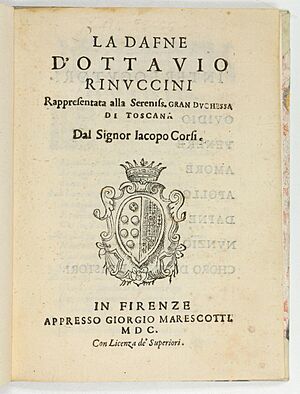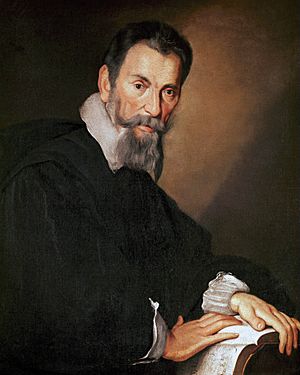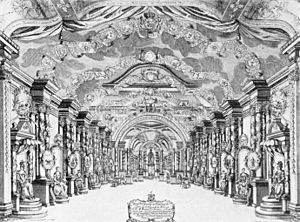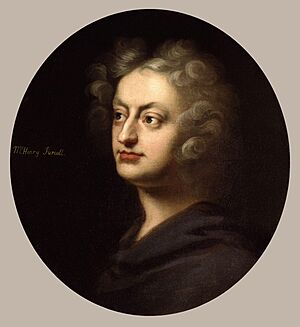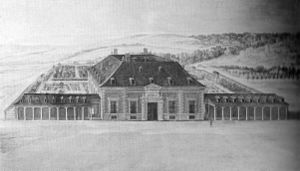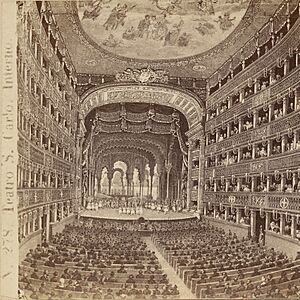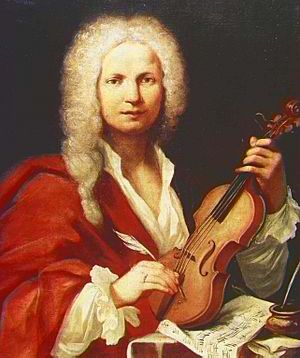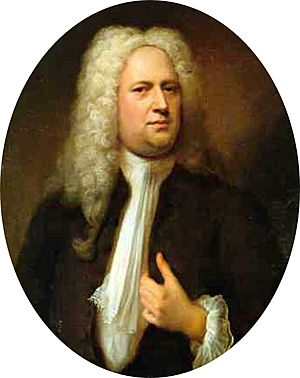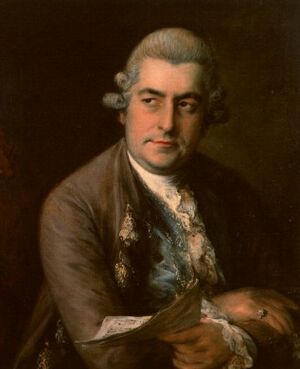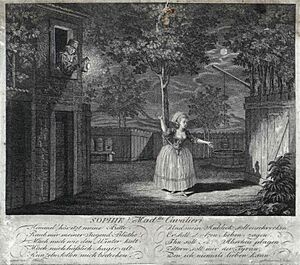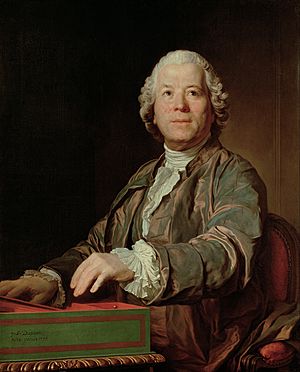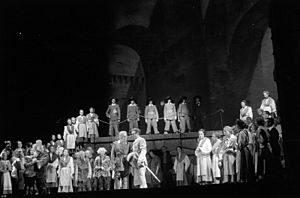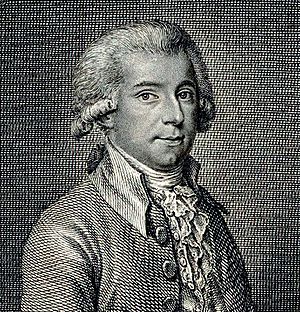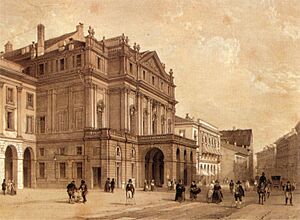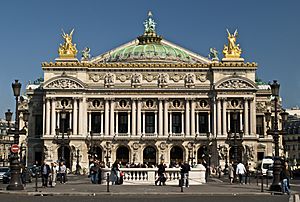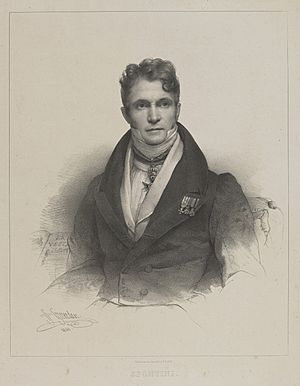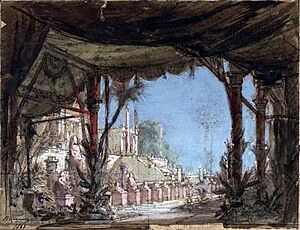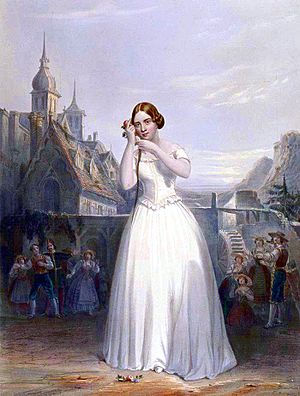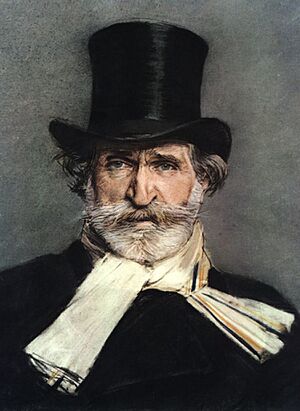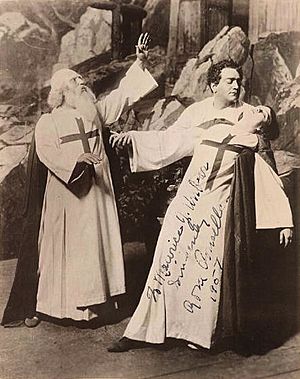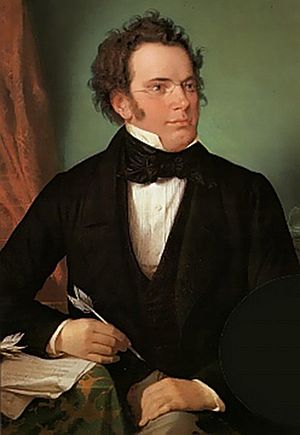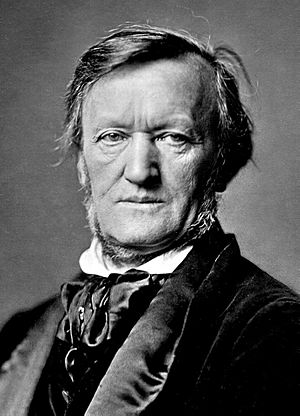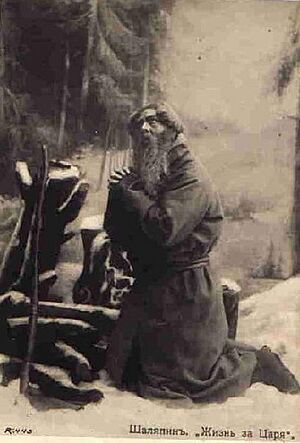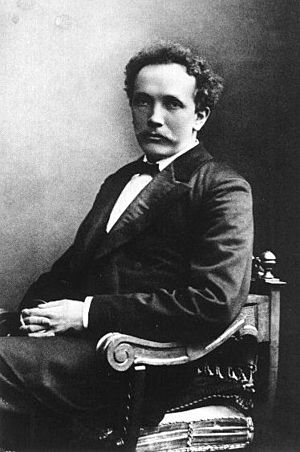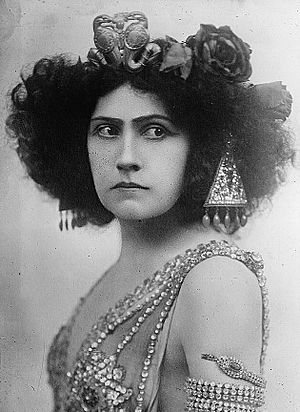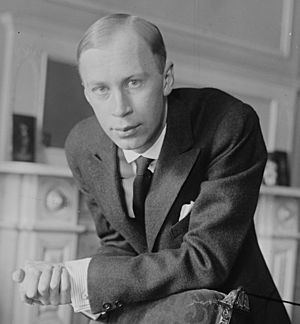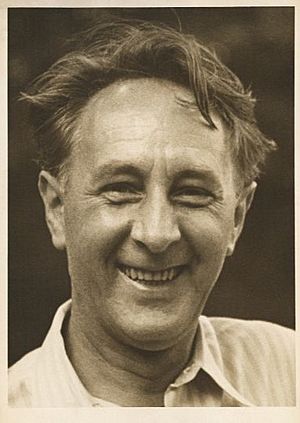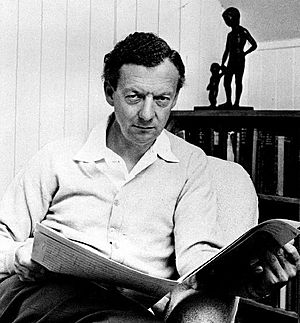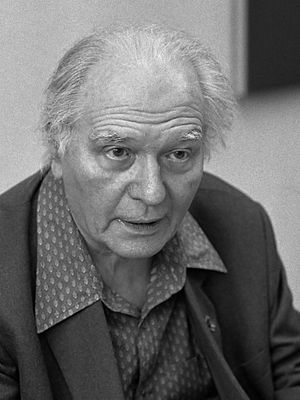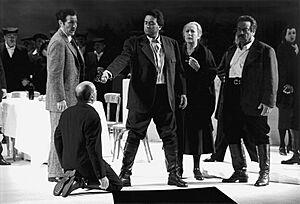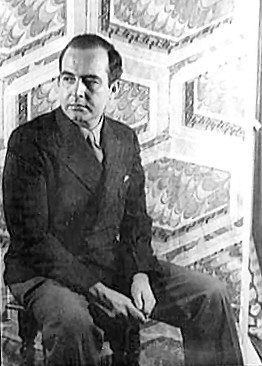History of opera facts for kids
The history of opera is quite short compared to the long history of music. It all started in 1597 with the first opera, Dafne, created by Jacopo Peri. Since then, opera has grown and changed alongside different music styles, becoming what we know today as classical music.
Opera comes from the Latin word opera, meaning "work." It's a type of musical show that mixes orchestral music with a written story, called a libretto. Singers with different voice types perform the story. Male voices include tenors, baritones, and basses. Female voices include sopranos, mezzo-sopranos, and contraltos. Sometimes, children's voices (called white voices) or falsetto voices (like countertenors) are also used.
An opera usually starts with an overture (a musical introduction) and has musical parts called interludes throughout. The singing can be done by a choir or by soloists, duets, trios, or other groups. Singers perform in different styles, like recitative (more like speaking) or aria (a more melodic song). There are many types of opera, such as classical opera, chamber opera, operetta, musical, singspiel, and zarzuela. Like plays, there are serious operas (opera seria) and funny ones (opera buffa), and even a mix of both called dramma giocoso.
Opera is a mix of many art forms. It brings together music, singing, dance, acting, scenography (set design), costumes, makeup, and hairdressing. It's a team effort, starting with a writer (librettist) and a composer. The singers are very important, but so are the musicians, the conductor, the dancers, and the people who create the sets and costumes. Opera also needs an audience to watch the show. Because of this, opera has always shown what society was like at the time, reflecting ideas about politics, religion, and culture.
Opera began in the late 1500s. A group of scholars in Florence, Italy, called the Florentine Camerata, discovered that ancient Greek plays were sung. This gave them the idea to set dramatic stories to music. So, Jacopo Peri created Dafne in 1597. Then came Euridice in 1600. In 1607, Claudio Monteverdi wrote La favola d'Orfeo. He added a musical introduction called a sinfonia and divided the songs into arias, which helped shape modern opera.
Opera continued to change with different music styles. In the 1600s and early 1700s, it was part of the Baroque period. During this time, opera became more complex in its music, singing, and stage design. The late 1700s brought Classicism, a time of calm and balanced music, with famous composers like Mozart and Beethoven. The 1800s were the age of Romanticism, where composers became celebrated artists. Opera became very popular with the middle class. This century also saw the rise of musical nationalism, where countries used their own folk music in operas. Later, French impressionism and Italian verismo appeared. In the 1900s, opera, like other arts, entered the avant-garde period, with new ways of composing and a wider audience reached through radio and television.
Throughout history, people debated what was most important in an opera: the music or the words. Some thought the singing and skill of the performers (called bel canto) were key. In the early days, the words and visual spectacle were more important. Claudio Monteverdi said, "the word must be decisive, it must direct the harmony." But after composers like Gluck and Mozart, music became more important. Mozart himself said, "poetry must be the obedient servant of music." Later, Richard Wagner tried to combine all arts into one "total work of art" (Gesamtkunstwerk).
Contents
How Opera Began
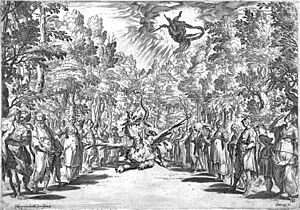
Opera has roots in older forms of sung or musical theater from around the world. People have always used drama, singing, music, and dance to express themselves. In Ancient Greece, theater was very popular. Plays were sung and had music, though little of that music survives today.
During the Middle Ages, music and theater were often religious. There were liturgical dramas performed in churches in Latin, and "mystery plays" performed outside in local languages. These plays mixed spoken and sung parts, often with choirs and instruments.
In Japan, nō theater appeared in medieval times. It was a lyrical drama with historical or mythological themes. A choir narrated, while actors moved rhythmically. China also developed Chinese opera, a sung theater where music created atmosphere.
In the Renaissance, new musical styles like the madrigal, oratorio, and intermedio helped lead to opera. The intermedio was especially important. These were short musical interludes performed between acts of a play. They combined singing, dancing, instrumental music, and special effects. They often told stories from Greek and Roman myths. Florence, Italy, where the Medici family lived, was a main center for these shows, and it's where opera was born.
The First Operas
In the late 1500s, in Florence, a group of scholars called the Florentine Camerata met to discuss arts, especially drama and music. They were supported by Count Giovanni de' Bardi. One scholar, Vincenzo Galilei (father of the famous scientist Galileo), studied ancient Greek theater. He found that Greek plays were sung by individual voices. This was a new idea because most music at the time was sung by choirs (called polyphony).
The Camerata decided to set dramatic stories to music, calling it opera in musica. Galilei believed in a single melodic line (called monody) instead of many voices singing at once. Another scholar, Girolamo Mei, noted how individual singing in Greek theater created strong emotions for the audience.
So, Jacopo Peri, a composer and member of the Camerata, created Dafne in 1597. It had a story by Ottavio Rinuccini, based on the myth of Apollo and Dafne. Only the words and small parts of the music survive. Peri himself sang the role of Apollo. In 1600, they created Euridice, the first complete opera that still exists. It was based on the myth of Orpheus and Eurydice and was performed for a royal wedding.
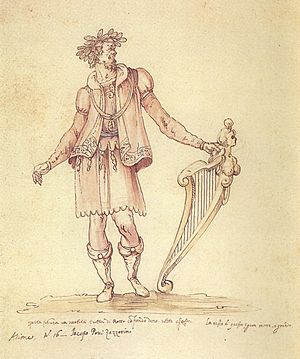
Another Camerata member, Giulio Caccini, also composed an Euridice in 1602. He wrote the first book explaining the new opera style, Le nuove musiche (1602). His daughter, Francesca Caccini, was the first woman to compose an opera: La liberazione di Ruggiero dall'isola d'Alcina (1625).
One big change with opera was that it was not religious, which was new for art and music at the time. Also, it used monody, a single voice with simple musical backing (called basso continuo). Early operas had parts sung by soloists and parts spoken or recited in a singing style called stile rappresentativo.
These first operas were very popular, especially with nobles like the Medici family. From Florence, opera spread across Italy. The Gonzaga family in Mantua asked Claudio Monteverdi to write an opera. He composed La favola d'Orfeo in 1607. This was a big work with an orchestra of 43 instruments. For the first time, printed librettos were given to the audience. Monteverdi added a musical introduction called a "symphony" and divided the songs into "arias," creating the structure for modern opera. These arias were mixed with recitatives, which were sung-spoken parts that moved the story along. He also added ritornellos, which were instrumental parts repeated between acts.
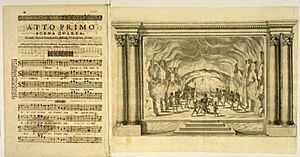
In the early 1600s, opera spread. In Rome, the Pope and the Barberini family supported opera. They even built a theater for 3000 people. They also helped create an opera school. Stefano Landi was one of these composers. His opera Il Sant'Alessio (1631) introduced religious themes and a fast-slow-fast musical introduction (called an Italian overture), which became very popular.
In Rome, Chi soffre, speri (1639) by Virgilio Mazzocchi and Marco Marazzoli is thought to be the first comic opera.
One of the first famous opera singers was Francesco Rasi, a tenor. He sang in Peri's Euridice and Monteverdi's Orfeo.
Baroque Opera
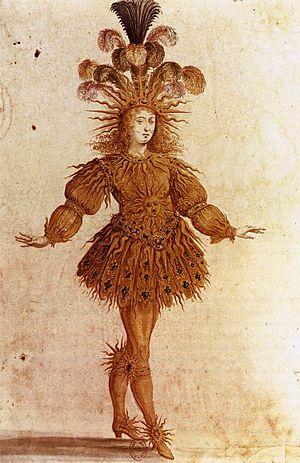
The Baroque period lasted through the 1600s and early 1700s. It was a time of big changes in politics and religion.
Baroque music often used strong contrasts, dramatic chords, and lots of decoration. But not all Baroque music was exaggerated; composers like Bach created balanced and calm pieces. This period also introduced musical terms like tempo (speed: largo, adagio, andante, allegro, presto) and intensity (forte and piano).
Baroque orchestras were small, usually around 40 instruments, mostly strings, with some woodwinds and trumpets. They also had a basso continuo section, often with a harpsichord and cello.
Baroque opera was known for its fancy and detailed stage designs. It often had sudden scene changes and special lighting effects. Many different sets were used, sometimes 15 or 20 in one show. People started to prefer solo high voices, like tenors and sopranos. Singing with vibrato (slight changes in pitch and volume) was also introduced, making performances more emotional.
In the early 1600s, the rules for opera stories were set. They had simple dialogues and clear forms. There was a clear difference between "recitative" (spoken-sung parts that move the story) and "number" (or "closed piece"), which were more decorative songs like arias or duets.
Venetian Opera
In the mid-1600s, Venice became a major opera center. It was the first place where opera was performed for the public, not just for religious or noble events. In 1637, the Teatro San Cassiano opened, the world's first public opera house. Since opera became a business, it started to depend on what the audience liked. People began to prefer high voices, and the use of choirs and large orchestras decreased. As opera became more popular, funny parts were added, and the stories were simplified. The singing became more important than the words. Many new theaters opened in Venice, and they started the typical opera house layout with boxes around the stage.
In Venice, the idea of bel canto (beautiful singing) became popular. This was a difficult singing technique that involved keeping a smooth, even tone while moving between notes. It required a powerful and clear voice. Also, the arioso appeared, a song style between recitative and aria. Over time, groups of voices singing together (called ensembles) became more common, like duets, trios, and quartets.
Venetian opera was influenced by Spanish theater, especially by Lope de Vega. This meant mixing fantasy and reality, ignoring strict rules, having both funny and sad characters, and using disguises. These features were called all'usanza spagnuola (in the Spanish style).
Claudio Monteverdi moved to Venice in 1613. He composed 12 operas there, including Il ritorno d'Ulisse in patria (1640) and L'incoronazione di Poppea (1642). L'incoronazione di Poppea is considered his best opera. It was one of the first operas with a historical story instead of a mythological one.
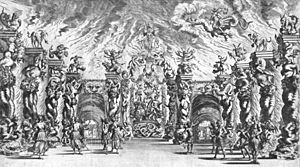
One of Monteverdi's students, Pier Francesco Cavalli, introduced new ideas like short arias. He was the director of the Teatro San Cassiano. Marc'Antonio Cesti reduced the orchestra even more. He also brought opera to the Germanic areas by performing for Emperor Leopold I. Antonio Sartorio introduced the "musical parliament" (a type of lament). His opera Orfeo (1672) was very successful. Giovanni Legrenzi composed heroic-comic operas.

In singing, Anna Renzi stood out. She was the first soprano to be called a prima donna (leading lady). She sang the role of Octavia in Monteverdi's L'incoronazione di Poppea.
French Opera
France was one of the first countries outside Italy to embrace opera, calling it tragédie en musique. The first Italian opera was performed in Paris in 1645. In 1669, Pierre Perrin and Robert Cambert started a company to perform French operas. They got permission from King Louis XIV to create the Académie Royale de Musique. They produced Pomone (1671), the first opera in French.
However, Jean-Baptiste Lully, a composer from Florence, took over the Académie Royale de Musique in 1672. Lully changed opera to fit French tastes. He added choirs, ballets, and richer orchestras. He also made musical interludes and shorter arias. He developed the French overture (slow-fast-slow), which became almost like a separate piece of music. Lully also made the words more important, making the opera more expressive. He adapted the singing to the French language, creating a unique French singing style. From 1673 until his death in 1687, he composed one opera a year, often with stories by Philippe Quinault. Some of his famous operas include Alceste (1674) and Armide (1686).
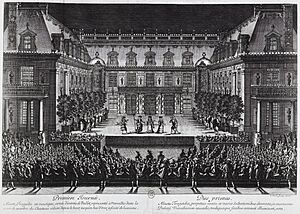
After Lully, the opera-ballet became popular in France. This was a mix of sung parts and danced interludes, often with funny and romantic themes. André Campra introduced this genre with L'Europe galante (1689).
Opera Spreads in Europe
Throughout the 1600s, opera spread across Europe, mostly influenced by Italian styles. In Germany, Heinrich Schütz adapted Dafne in 1627. In 1644, Sigmund Theophil Staden composed Seelewig, the first opera in German. The Oper am Gänsemarkt in Hamburg opened in 1678, becoming a leading opera city. Reinhard Keiser was the first to write operas entirely in German, composing many successful works like Adonis (1697) and Croesus (1710).
In England, there was a type of musical play called a masque. During the English Revolution, music was banned. But the first English opera, The Siege of Rhodes, was performed in 1656. Later, Henry Purcell became a notable opera composer. His Dido and Aeneas (1689) is a short but famous work, especially its final song, "Dido's lament". He also composed "semi-operas" that mixed songs, choirs, and dances.
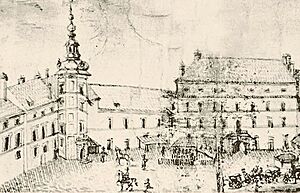
In Poland, King Ladislaus IV supported opera. In 1632, he created a company with Italian singers in Warsaw. The first opera by a Polish composer, La fama reale (1633) by Piotr Elert, was performed there.
In Spain, opera arrived a bit later. The first opera, La selva sin amor, was performed in 1627. Tomás de Torrejón y Velasco composed La púrpura de la rosa (1659), the first opera performed in America (in Lima, Peru). King Felipe IV supported operettas at the Zarzuela Palace in Madrid, which led to the new genre of zarzuela. The first zarzuelista was Juan Hidalgo.
Neapolitan Opera
In the late 1600s, the Neapolitan School in Naples, Italy, created a simpler, more refined opera style. Naples was under Spanish rule, and the Spanish viceroys supported opera. They made a clear difference between two types of recitative: secco (spoken-sung with simple backing) and accompagnato (more melodic with orchestra). Singers were allowed to improvise in arias. Funny characters were removed from serious operas, which led to short comic intermezzi being performed between acts. In 1737, the famous Teatro San Carlo in Naples opened.
Alessandro Scarlatti was the most important composer of this school. He was a chapel master and theater director. He introduced many new ideas, like the three-part aria (aria da capo), which had an A-B-A structure. He reduced vocal decorations and made arias longer and recitatives shorter. He also added shorter arias called cavatinas for faster parts. Scarlatti's music was simpler but charming. He composed 114 known operas. His son, Domenico Scarlatti, also composed operas.
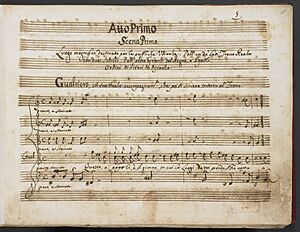
Giovanni Battista Pergolesi was another important composer. He died young but had a successful career. His comic opera Lo frate 'nnamorato (1732) was very popular. His comic play La serva padrona (1733), performed between acts of a serious opera, became even more famous than the main work.
Nicola Porpora was a famous singing teacher. He composed many operas and worked in Venice, London, and Vienna. Other important composers of the Neapolitan school included Leonardo Vinci, Leonardo Leo, and Giovanni Bononcini.
Late Baroque: Opera Seria and Opera Buffa

The first half of the 1700s is called the late Baroque. Italy, especially Naples and Venice, remained the main opera center. Italian opera spread throughout Europe. Stage design also improved greatly, with artists like Ferdinando Galli Bibbiena introducing new stage effects. This was the golden age of bel canto, with famous prime donne (leading female singers).
Around this time, opera split into two main types: opera seria (serious opera) and opera buffa (comic opera). Opera seria usually told stories from classical mythology, with a moral lesson. It focused on heroes and their virtues. The story was told in recitatives, and the arias were for singers to show off their voices, especially with the da capo aria. Serious opera aimed to be more simple and noble, like ancient Greek theater.
However, audiences missed the funny characters. So, short comic intermezzi were added between acts. These became so popular that they grew into their own separate shows, leading to opera buffa. Opera buffa was funny and for a wider audience, influenced by popular Italian theater (Commedia dell'arte). It had shorter arias and used natural voices. It also included duets, trios, and quartets, which were rare in opera seria. A fast, spoken-sung style called parlando was common. The music was simple, often with small orchestras. Eventually, serious and comic opera began to mix, creating semi-serious opera or dramma giocoso.
In opera seria, two librettists (story writers) were more famous than the composers: Apostolo Zeno and Pietro Metastasio. Zeno introduced historical themes and stories with a code of honor. Metastasio, who followed Zeno, wrote 27 librettos that were set to music in about 100 operas. His stories were elegant and gave more importance to solo singers. Zeno and Metastasio introduced the "doctrine of the affections," where each emotion (love, sadness, hope) was expressed by a specific musical form.
Venice remained an important opera center. Antonio Vivaldi, a major composer of the Italian late-Baroque, stood out. He was a chapel master and is considered the first great master of orchestral music. He composed about 50 operas. Other Venetian composers included Tomaso Albinoni and Francesco Gasparini.
The Neapolitan school also continued. Its main composers were Niccolò Jommelli and Tommaso Traetta. Jommelli's style became more Germanized after he worked in Stuttgart. Traetta combined Gluck's influence with his own elegant melodies.
The Spanish composer Domingo Terradellas is considered part of the Neapolitan school. He studied in Naples and composed operas in Rome and London.
In opera buffa, Carlo Goldoni was a famous librettist. He wrote about 100 librettos, adding elements of Commedia dell'arte. His stories featured real characters and everyday events, with simpler plots and witty dialogues. His work influenced Mozart and later Rossini and Donizetti.
Niccolò Piccinni and Baldassare Galuppi were important opera buffa composers. Piccinni was very prolific. His La Cecchina, ossia la buona figliuola (1760) is considered the first semi-serious opera. Galuppi's L'Arcadia in Brenta (1749), with a libretto by Goldoni, was the first long opera buffa. Their most famous joint work was the dramma giocoso Il filosofo di campagna (1754).
During this period, the pasticcio appeared, an opera created by several composers working together.
In singing, sopranos Francesca Cuzzoni, Margherita Durastanti, and Anna Maria Strada, and mezzo-soprano Faustina Bordoni were famous. Bordoni and Cuzzoni were known for their strong rivalry.
France
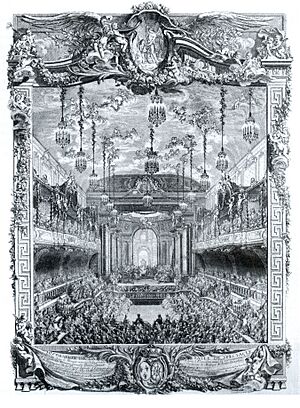
In France, the Lullian tragédie-lyrique (lyric tragedy) was still popular, with a focus on ballet. French operas had five short acts with ballets. Jean-Philippe Rameau was the most prominent composer. He wrote his first opera, Hippolyte et Aricie (1733), at age 50. His works included Les Indes galantes (1735) and Castor et Pollux (1737). Rameau's operas were very popular but also caused debates between those who liked Lully's traditional style and those who preferred Rameau's new, more music-focused approach.

The philosopher Jean-Jacques Rousseau, also a composer, wrote Le devin du village (1752). It was not high quality, but it was important for showing country characters as simple and good, contrasting with the corrupt nobility.
In France, opera buffa had its own version called opéra-comique. These were simpler shows with everyday stories, often making fun of social customs. They mixed songs with spoken dialogue. The Théâtre National de l'Opéra-Comique was created for these performances. François-André Danican Philidor and André Ernest Modeste Grétry were key composers. Philidor introduced sounds like a hammer or a donkey's braying into his works. Grétry was known for his elegant melodies. His greatest success was Richard Cœur-de-lion (1784).
Germany and Austria
Germany did not develop its own unique opera style at first, mostly following Italian opera. However, the singspiel emerged, a lighter comic genre similar to French opéra-comique, mixing dialogue with music.
Georg Philipp Telemann composed operas with Italian arias and German recitatives. He was a very productive musician.
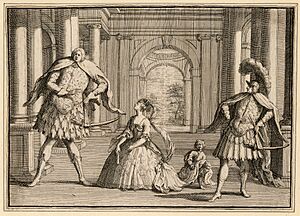
One of the best opera composers of this time was Georg Friedrich Händel. He composed his first opera, Almira, in 1705. He traveled to Italy and was influenced by Italian and French styles, but kept his German character. In 1710, his Agrippina was a big success in Venice. He later moved to England, where he composed most of his 42 operas. His works were usually grand and serious, often about ancient heroes. He used choirs but not ballets. His regular librettist was Nicola Francesco Haym.
Other important composers were Johann Adolph Hasse, who promoted opera seria, and Johann Joseph Fux.
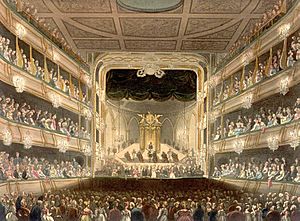
In England, Italian opera remained popular. However, audiences eventually grew tired of Händel's serious operas. This led to the success of The Beggar's Opera (1728), a kind of anti-opera with music by Johann Christoph Pepusch and words by John Gay. This work started the ballad opera genre, which was like an operetta, using folk songs and dances. Short plays called afterpieces were also performed during theater intermissions.
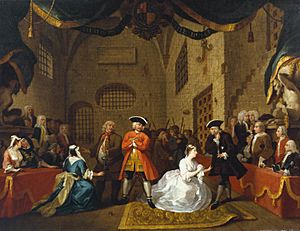
Thomas Arne made a last attempt at English opera with Artaxerxes (1762), sung in English.
In Spain, Italian opera was favored by the new Bourbon kings. However, during the reign of Carlos III, zarzuela briefly returned to popularity. Ramón de la Cruz wrote many sainetes (short, funny plays) that showed Madrid life.
Galant Music and Gluck's Reforms
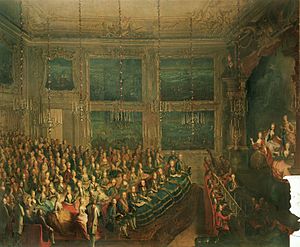
In the mid-1700s, people started to criticize opera seria for being too focused on vocal show-offs. This was the time of rococo art, and in music, it led to galant music. This style was calmer, lighter, and simpler than Baroque music, focusing on gentle melodies and sentiment. It moved away from strong contrasts and aimed for smooth changes in sound. The Mannheim School developed symphonic music with the first large modern orchestra.
The main center for galant music was Germany and Austria. Johann Christian Bach, son of Johann Sebastian Bach, was a key figure. He combined the simplicity of Italian music with German precision. He influenced Mozart, even giving him lessons as a child.
In Austria, the singspiel had its golden age. Emperor Joseph II dedicated the Burgtheater in Vienna to this genre. Johann Adam Hiller and Georg Anton Benda were important singspiel composers.
A major reform in opera was led by the Bohemian-Austrian composer Christoph Willibald Gluck. He believed the story should be more important than vocal show-offs. He made the music simpler, without too much decoration. He also made the overture, choir, and ballet part of the opera's action. He wanted music to serve the text, making both elements work together. Gluck introduced the "tableau" concept, where each act was a complete dramatic and musical unit.
His famous works include Orfeo ed Euridice (1762) and Alceste (1767). During his time in France, there was a debate between supporters of Gluck's reforms and those who preferred Italian opera.
Classical Opera
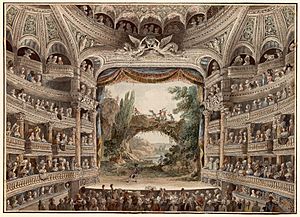
The Classical period (late 1700s to early 1800s) brought balance, serenity, and formal beauty to music. It aimed for a universal musical language. Opera remained popular but evolved. It used more duos, trios, and other ensembles, as well as choirs. The orchestra grew, and instrumental music became more important. The famous La Scala Theater in Milan opened in 1778, and the La Fenice Theater in Venice opened in 1792.
The main composers of Classicism were Franz Joseph Haydn, Wolfgang Amadeus Mozart, and Ludwig van Beethoven. Haydn, known as the father of the symphony, composed several comic operas for the Esterházy court.
Wolfgang Amadeus Mozart was the most important composer of Classicism. He was a child prodigy who traveled Europe and learned about different music styles. His early works included the singspiel Die Schuldigkeit des ersten Gebots (1767) and the operetta Apollo et Hyacinthus (1768). His first serious opera, Mitridate, re di Ponto (1770), was a success.
After moving to Vienna, Mozart composed Die Entführung aus dem Serail (The Abduction from the Seraglio, 1782). This opera broke from the Baroque style by including real characters and different musical styles, like folk music. He also introduced an aria with two parts, one slow and one fast (a cabaletta).
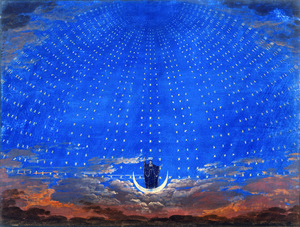
In 1786, Mozart composed Le Nozze di Figaro (The Marriage of Figaro), a comic opera with a libretto by Lorenzo da Ponte. It showed his skill in using vocal ensembles and creating psychological depth in characters. The next year, he created Il dissoluto punito, ossia il Don Giovanni, also with Da Ponte, mixing tragedy and comedy. His last two operas were La clemenza di Tito (1791), a serious opera, and Die Zauberflöte (The Magic Flute, 1791), a singspiel that mixed fairy tale with Masonic ideas.
Ludwig van Beethoven was another great composer, bridging Classicism and Romanticism. His only opera was Fidelio (1805), a serious singspiel about love and freedom. It showed Mozart's influence and had powerful orchestral music.
In Italy, Giovanni Paisiello and Domenico Cimarosa were important. Paisiello composed about 80 operas, including Il barbiere di Siviglia (1782). Cimarosa was very prolific, with about 60 operas. His greatest success was Il matrimonio segreto (1792).
Antonio Salieri was a court composer in Vienna and later director of the Paris Opera. He composed about 30 operas, both serious and comic.
In Spain, Vicente Martín y Soler gained international fame. He composed operas in Italy and Vienna. His Una cosa rara, ossia bellezza ed onestà (1786) was so popular it overshadowed Mozart's Le Nozze di Figaro.
In Russia, Empress Catherine II brought many Italian composers to St. Petersburg. The first opera in Russian was by an Italian, Francesco Araja. Russian composers like Vasili Pashkévich and Dmitri Bortniansky also began writing operas.
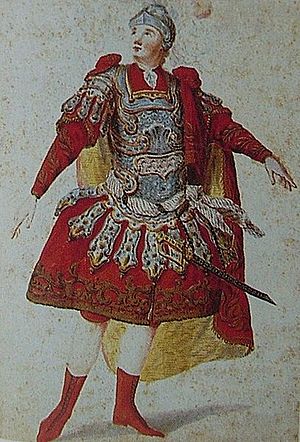
Notable singers of this period included Austrian soprano Caterina Cavalieri and English soprano Nancy Storace, for whom Mozart wrote roles. German tenor Anton Raaff was also very famous.
19th Century: Romantic Opera
The 1800s saw big changes in society, with the end of absolute monarchies and the rise of democracy and capitalism. Music reflected these changes. Composers and performers became more independent from royal and church support, relying instead on the public, especially the growing middle class.
Opera became grander, with larger stages, elaborate sets, and bigger orchestras. Singers had to develop more powerful voices to be heard over the instruments. New voice types emerged, like the "dramatic soprano" and "robust tenor."
In the second half of the century, the operetta became popular. This was a lighter opera genre with dances and songs mixed with spoken dialogue. It became established in France and Vienna. This type of work eventually led to modern musicals.
Stage technology advanced significantly. In 1822, gas light was first used at the Paris Opera. In 1849, electric light appeared. Set designers like Pierre-Luc-Charles Cicéri created huge, clever sets with special effects. The Paris Opera became one of the most prestigious theaters in the world.
Romanticism in Music
Romantic music focused on feelings and passion, the artist's emotions, and national pride. Orchestras grew even larger to express these new feelings. Individuality and imagination were key. Composers imitated sounds from nature, like storms and avalanches. The piano became a very important instrument, and new instruments like the harp and English horn were added to the orchestra. Conductors became more important, and some, like Carl Maria von Weber, started using a baton.
Opera thrived in this period, especially in Italy, which was the golden age of bel canto. Singers showed off their vocal skill and ornamentation. The soprano became very important, and the "high C" became popular for tenors. Romantic opera had both comic and dramatic sides, often based on popular literary dramas. The difference between recitative and aria became less clear. Romantic opera also used folk themes and stories from a country's history and myths. There was also a new interest in "gothic" themes, leading to darker operas.
Opera stories changed to include new themes, often from popular novels. Walter Scott's novels inspired many operas, as did texts by Johann Wolfgang von Goethe and Friedrich von Schiller.
France
French romantic opera began after the French Revolution. It moved away from classical myths and focused on popular heroes and intense emotions. Early composers like Étienne Nicolas Méhul created works where characters faced dramatic situations.
Two Italian composers in France, Luigi Cherubini and Gaspare Spontini, were early leaders of French romantic opera. Cherubini's Médée (1797) was a masterpiece. Spontini introduced many elements of grand-opéra, like large choirs and elaborate stage productions, seen in Fernand Cortez (1809).

Daniel-François-Esprit Auber was a master of opéra-comique. Jacques Fromental Halévy's masterpiece was La Juive (The Jewish Woman, 1835), known for its grand tragic feeling.
The German composer Giacomo Meyerbeer was a major force in grand-opéra. His Robert le diable (1831) and Les Huguenots (1836) were known for their lavish staging. Robert le diable included the famous "Ballet of the Nuns," which introduced the classic ballet costume (the tutu).
Hector Berlioz focused on epic opera. His major work was Les troyens (1856–1858), based on Virgil's The Aeneid.
Later in the century, Georges Bizet composed his masterpiece, Carmen (1875). Set in Spain, it used realistic elements and Spanish folk music and dances.
Charles Gounod's masterpiece was Faust (1859). Ambroise Thomas was influenced by Gounod, seen in his operas Mignon (1866) and Hamlet (1868).
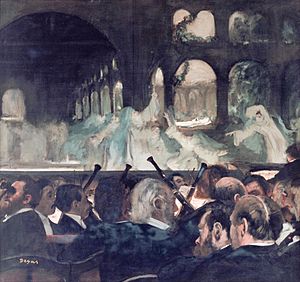
Jacques Offenbach excelled in comic operetta. His Orphée aux enfers (Orpheus in the Underworld, 1858) was a funny take on Greek myths. Other hits included La belle Hélène (1864) and La vie Parisienne (1866).
Camille Saint-Saëns composed 13 operas. His greatest success was Samson et Delilah (1877), based on the biblical story.
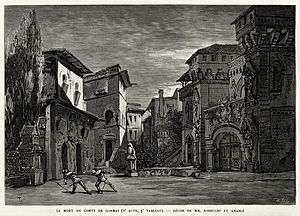
Jules Massenet was a very successful opera composer. His works included Manon (1884), Le Cid (1885), and Werther (1892).
Italy
In Italy, Romanticism in opera had a strong nationalistic feel, helping to unite the country. It was the era of bel canto, with a focus on beautiful voices.
Gioachino Rossini was a key composer, bridging Classicism and Romanticism. He added more wind instruments to the orchestra. His early comic operas were dynamic and lively. In 1816, his Il barbiere di Siviglia (The Barber of Seville) became one of his greatest successes. He also composed serious operas like Otello (1816). Rossini stopped composing at age 36.
Vincenzo Bellini and Gaetano Donizetti were the next big names. Bellini created more emotional and dreamy works, known for their long, lyrical melodies. His most famous opera is Norma (1831), which includes the famous aria Casta Diva.
Donizetti achieved international success with Anna Boleyn (1830). He composed for Milan, including L'elisir d'amore (1832), a sentimental comedy with the famous aria Una furtiva lagrima. His dramatic opera Lucia di Lammermoor (1835) was very popular. He also composed La Fille du régiment (1840) and La favorite (1840) in Paris. Donizetti composed 67 operas in total.
Late Romanticism in Italy was dominated by Giuseppe Verdi. His operas often had a strong nationalistic message, becoming symbols of Italy's unification. His early works followed bel canto forms, but he gradually moved towards musical drama, focusing on melody.
His first success was Oberto, Conte di San Bonifacio (1839). Nabucco (1842) was a huge hit, with its story of Hebrew captivity compared to Italy's foreign rule. It includes the famous choir Va, pensiero. His opera Macbeth (1847) broke with bel canto by using a soprano with an "ugly" voice for Lady Macbeth.
Verdi's three masterpieces are Rigoletto (1851), Il trovatore (1853), and La Traviata (1853). These were more realistic dramas. Rigoletto included a motiv (a musical idea linked to a character or feeling), like in the famous aria La donna è mobile. Il trovatore had a wide range of melodies, including the famous gypsy choir. La Traviata included the famous duet Libiamo ne' lieti calici (the "toast").
His later works included Aida (1871), a grand production set in ancient Egypt, and his last two operas, Otello (1887) and Falstaff (1893), both based on Shakespeare.
After Verdi, Arrigo Boito and Amilcare Ponchielli were important. Boito composed Mefistofele (1868). Ponchielli's only successful opera was La Gioconda (1876).
Germanic Countries
In Germany, Italian influence slowly faded, thanks to Richard Wagner. In Austria, the Wiener Staatsoper (Vienna State Opera) opened in 1869, becoming a major European opera center.
Carl Maria von Weber is considered the creator of German national opera. His main opera is Der Freischütz (The Poacher, 1821), which used folk legends and elements of nature, mystery, and magic. It was the first truly Romantic German opera.
The Austrian Franz Schubert, famous for his songs (lieder), also composed operas. His plots often failed him, but his music was beautiful.
Other famous Romantic composers like Felix Mendelssohn, Robert Schumann, and Franz Liszt also tried opera.
Richard Wagner was a towering figure. He aimed to create a "total work of art" (Gesamtkunstwerk) that combined music, poetry, drama, and other arts. He disliked the term "opera," preferring "musical drama." He made the orchestra much larger, even adding a special Wagnerian tuba. His operas required singers with special training.
Wagner criticized Italian opera. He removed arias and "closed numbers," creating continuous musical flow. He was the first to darken the hall and focus attention on the stage. He also forbade applause during the performance. Another of his innovations was the leitmotif, a musical idea linked to a character, feeling, or object. Wagner wrote his own librettos, controlling every part of his works.
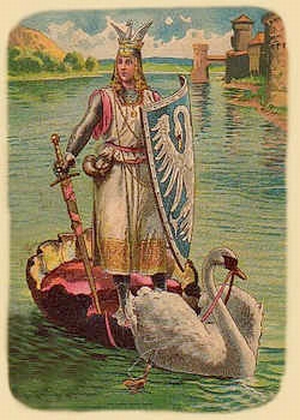
His early operas included Rienzi (1842) and Der fliegende Holländer (1843). These began a series of works based on Germanic themes, often set in the Middle Ages, with romantic loves and themes of redemption through death. Lohengrin (1850) was his first opera without separate arias, using continuous melodic scenes.
His biggest project was the tetralogy Der Ring des Nibelungen (The Ring of the Nibelung), made of four operas: Das Rheingold, Die Walküre, Siegfried, and Götterdämmerung. This huge work took him 26 years to compose. He also composed Die Meistersinger von Nürnberg (The Master Singers of Nuremberg, 1868) and his last work, Parsifal (1882).
In the second half of the century, operetta saw a revival in Austria. Johann Strauss II was its most famous composer, known for his waltzes and operettas like Die Fledermaus (The Bat, 1874). Franz Lehár and Franz von Suppé were also important operetta composers.
Romantic Singers
- Isabella Colbran: Spanish mezzo-soprano, Rossini's wife, one of the first "divas."
- Julián Gayarre: Spanish tenor with a wide international career.
- Jenny Lind: Swedish soprano and prima donna, one of the most famous of the century.
- Giuditta Pasta: Italian soprano, a top bel canto singer.
- Adelina Patti: Italian soprano and diva, considered the best of the late 1800s.
- Giovanni Battista Rubini: Italian tenor with a sweet but powerful voice.
- Ludwig Schnorr von Carolsfeld: German tenor, the first Wagnerian heldentenor (heroic tenor).
- Francesco Tamagno: Italian tenor famous for his high C.
Nationalism in Opera
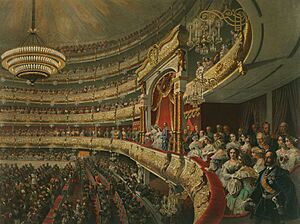
In the late 1800s, many nations that hadn't been known for music experienced a musical rebirth. This was fueled by nationalist feelings and political changes. Composers used their countries' folk and popular traditions in their music. Most stories were historical and national, and operas were written in local languages. For countries without political independence, opera became a way to express national identity.
Russia
Russian music was known for its colorful sounds, brass instruments, and melancholic spirit. Ballets and folk dances were also popular. Mikhail Glinka is called the "father of Russian music." His Zhizn za tsaryá (1836) used Russian folk melodies. Ruslan and Liudmila (1842) started the "magical opera" genre in Russia.
A group of composers called The Five (Aleksandr Borodín, César Cui, Modest Músorgski, and Nikolái Rimski-Kórsakov) wanted to create a unique Russian music. Aleksandr Borodin's masterpiece was Kniaz Igor (Prince Igor). Modest Músorgski's masterpiece was Boris Godunov, which used a spoken-sung style based on Russian language.
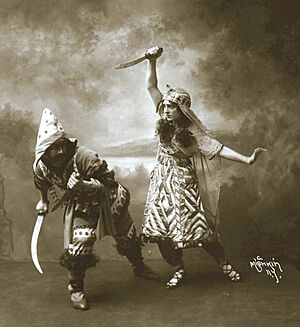
Nikolái Rimski-Kórsakov was known for his orchestral skill and harmonies. His greatest success was Zolotoi Petushok (The Golden Cockerel, 1909).
Pyotr Tchaikovsky was a sensitive composer. His masterpiece was Evgeni Onegin (1879). He was the most European of the Russian composers and is often called "the last Romantic."
English-Speaking Countries
In the United Kingdom, there were attempts to create an English opera style. While serious opera didn't take off, comic opera was more successful. The team of Arthur Sullivan (composer) and W. S. Gilbert (writer) created a new genre called Savoy opera. Their best works were The Mikado (1885) and The Gondoliers (1889).

In the United States, European opera was very popular. The Metropolitan Opera House opened in New York City in 1883. In the 1900s, American opera began to include elements of popular music like jazz. George Gershwin combined classical music with jazz and blues in his folk-opera Porgy and Bess (1935).
Post-Romanticism
From the late 1800s to early 1900s, post-Romanticism evolved from Romanticism, often influenced by Wagner.
Richard Strauss was a key figure, known for his harmonies and orchestration. His opera Salome (1905), based on Oscar Wilde's play, was a success. He often worked with playwright Hugo von Hofmannsthal. Their works included Elektra (1909) and Der Rosenkavalier (The Knight of the Rose, 1911). Strauss's music pushed traditional boundaries, with passionate sounds.
Engelbert Humperdinck was an assistant to Wagner. His most successful opera was Hänsel und Gretel (1893), based on the fairy tale.
Impressionism
Impressionism started in France in the late 1800s, aiming to modernize music. Like Impressionist painting, it captured sensations and feelings, using new scales and harmonies.
Claude Debussy was the main representative. His only opera, Pelléas et Mélisande (1902), was a masterpiece. It was a "literary opera," respecting the original text and using a continuous, spoken-sung style.
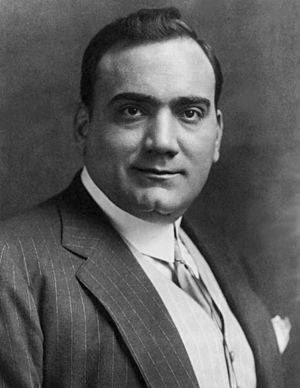
In France, Maurice Ravel and Paul Dukas also stood out. Ravel's L'heure espagnole (The Spanish Hour, 1911) was a comic opera with sound effects.
Singers of the End of the Century
- Enrico Caruso: Italian tenor, one of the most famous of all time, known for his flexible voice.
- Fyodor Chaliapin: Russian bass, famous for roles in Russian and Italian operas.
- Mary Garden: American soprano, excelled in Debussy's Pelléas et Mélisande.
- Nellie Melba: Australian soprano of great skill.
- Claudia Muzio: Italian soprano, excelled in tragic roles.
20th Century Opera
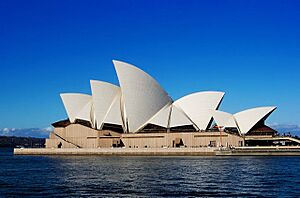
The 20th century brought huge changes to music, driven by political and social shifts. New technologies like electronic music led to new ways of composing. Harmony, melody, and tonality were often broken. This new music was sometimes hard for the public to understand, especially atonality, where all notes have equal importance.
Opera in the 20th century continued to perform older works, but new operas often experimented with sound. Composers faced criticism and even political persecution. In the Soviet Union, Stalin censored Dmitri Shostakovich's Lady Macbeth of Mtsensk. In Nazi Germany, avant-garde composers were called "degenerate musicians."
Despite challenges, opera singers remained popular, sometimes becoming huge stars like The Three Tenors (Luciano Pavarotti, José Carreras, and Plácido Domingo). Voice recording, radio, cinema, and television helped spread opera to wider audiences. In 1951, Amahl and the Night Visitors by Gian Carlo Menotti was the first opera composed for television.
Stage design also evolved, with more realistic sets. Max Reinhardt introduced three-dimensional sets and special lighting.
The chamber opera emerged, a smaller-scale opera with few characters and a small orchestra. Benjamin Britten even founded his own chamber opera orchestra. Operetta evolved into the modern musical. Opera festivals also became popular around the world.
Expressionism
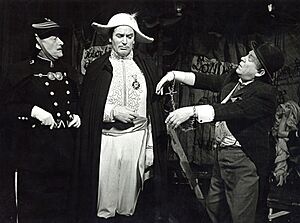
Expressionism in opera focused on inner feelings and psychological depth. Art was seen as a way to express ideas, not just entertain.
In France, a group called Les Six experimented with new musical forms. Francis Poulenc wrote lyrical operas like Dialogues des Carmélites (1957). Darius Milhaud composed historical works. Arthur Honegger also contributed.
In Germany, Franz Schreker's Der ferne Klang (The Far Sound, 1910) was a success. Paul Hindemith experimented with different styles. Kurt Weill was known for his "New Objectivity" style, mixing classical music with jazz and cabaret. He worked with playwright Bertolt Brecht on hits like Die Dreigroschenoper (The Threepenny Opera, 1928).
Dodecaphony
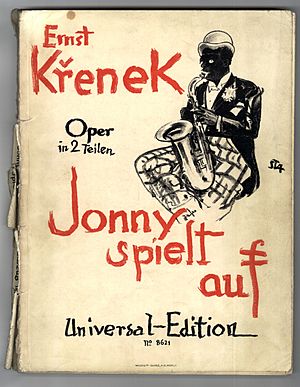
Arnold Schönberg created dodecaphonism, a system where all 12 notes of the scale are equally important, breaking traditional harmony. His operas included Moses und Aron. The great atonal opera was Wozzeck (1925) by Alban Berg, a complex work that explored psychological states. His second opera, Lulu, was also close to dodecaphonism.
Ernst Krenek's Jonny spielt auf (1927) was very popular, influenced by jazz and other modern styles.
Neoclassicism
Neoclassicism returned to the clear, balanced style of 18th-century classical music. It was popular in the 1920s and 1930s.
Igor Stravinsky was a genius who experimented with many styles. His first opera was Le rossignol (1914). His only full-length opera was The Rake's Progress (1951).
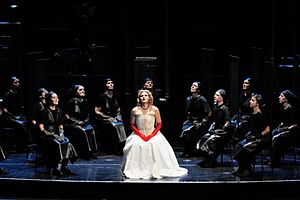
Dmitri Shostakovich composed under Soviet censorship. His masterpiece was Ledi Mákbet Mtsénskogo Uyezda (Lady Macbeth of Mtsensk, 1936), which was disliked by Soviet authorities for its dissonant style.
Sergey Prokofiev combined traditional music with experimental features. His operas included The Love of the Three Oranges (1919) and Vojna i Mir (War and Peace, 1946).
The Czech Bohuslav Martinů mixed neoclassicism with jazz and gospel music.
Post World War II: Tradition and Avant-Garde
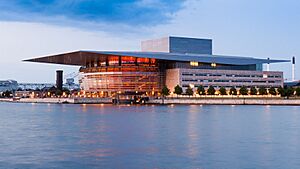
After World War II, opera continued to split between traditional styles and new avant-garde movements like concrete music and minimalism. These new styles were often difficult for the public to understand.
In the 1960s, opera saw a comeback. Some composers created "anti-operas" that broke down traditional forms. Later, "anti-anti-operas" emerged, bringing back narrative but with a modern, often ironic, style.
United Kingdom
Benjamin Britten was a very productive opera composer. His works often explored themes of loneliness and pain, like in Peter Grimes (1945). He also composed chamber operas and founded the English Opera Group. His opera Billy Budd (1951) was based on a text by Herman Melville. For the coronation of Elizabeth II, he composed Gloriana (1953). His last work was Death in Venice (1973).

Michael Tippett was inspired by Mozart for his first opera, The Midsummer Marriage (1955). His later works included elements of rap.
Mark-Anthony Turnage created innovative works with strong jazz influence. His opera Greek (1988) required singers to sound less like traditional opera singers.
France and Italy
In France, Olivier Messiaen was a major musician. He composed only one opera, Saint-François d'Assise (1983), a highly staged work.
In Italy, Luigi Dallapiccola used serialism in his operas, like Il prigioniero (1949). Luigi Nono moved from serialism to electronic music. Luciano Berio composed operas like Un re in ascolto (1984) with librettos by Italo Calvino. He also composed a new ending for Puccini's Turandot.
United States
In the United States, Samuel Barber was known for his melodic, post-romantic style. His most famous opera was Vanessa (1957), which won a Pulitzer Prize. Gian Carlo Menotti was known for his melodramatic operas, like Amahl and the Night Visitors (1951).
Leonard Bernstein composed musicals and film scores. His opera Trouble in Tahiti (1951) mixed opera with pop music.
John Adams is a minimalist composer who also uses elements of jazz, ragtime, and rock. His operas include Nixon in China (1987) and The Death of Klinghoffer (1991).
Philip Glass is a leading minimalist composer. His first opera, Einstein on the Beach (1976), made him famous. He also composed a trilogy based on films by Jean Cocteau.
Singers of the 20th Century
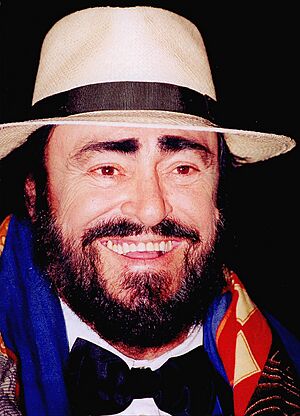
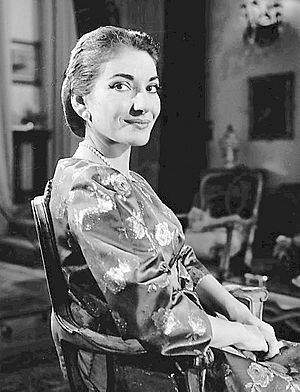
- Victoria de los Ángeles: Spanish soprano with great stage presence.
- Maria Callas: Greek soprano, one of the most famous divas ever, known for her dramatic intensity and technical skill.
- José Carreras: Spanish tenor, part of The Three Tenors.
- Enrico Caruso: Italian tenor, one of the most famous of all time.
- Plácido Domingo: Spanish tenor, known for a wide variety of roles.
- Juan Diego Flórez: Peruvian light tenor, specialist in Rossini and Donizetti.
- Alfredo Kraus: Spanish light lyric tenor.
- Luciano Pavarotti: Italian tenor, one of the most famous and charismatic of recent times.
- Joan Sutherland: Australian soprano, known for her vocal skill in bel canto.
Images for kids
-
Performance of the opera Armide by Jean-Baptiste Lully in Paris (1761).
See also
 In Spanish: Historia de la ópera para niños
In Spanish: Historia de la ópera para niños
- Classical music
- History of music
- History of theatre
- List of prominent operas


